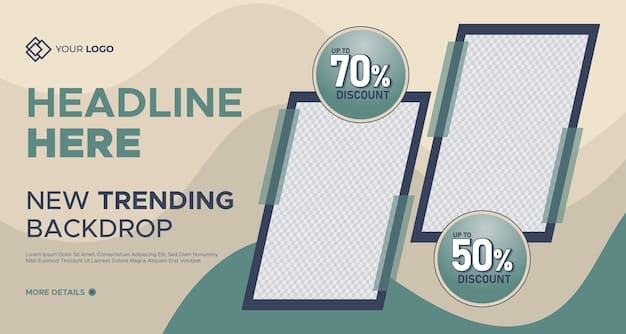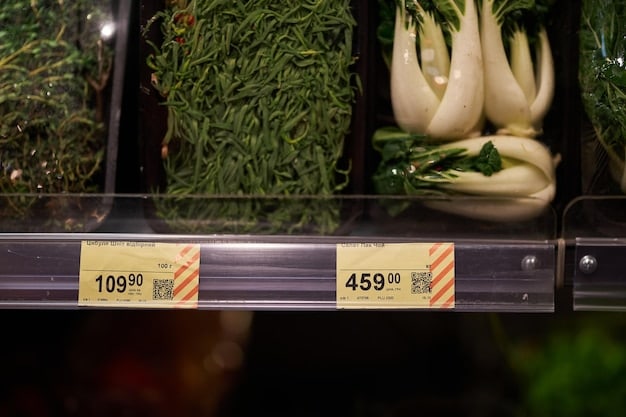Unlock Grocery Savings: The Power of Unit Pricing

Understanding unit pricing is a powerful tool for grocery savings, allowing consumers to compare costs effectively regardless of package size and ultimately make more informed purchasing decisions.
Are you tired of overspending at the grocery store? The secret to maximizing your savings might be simpler than you think. It’s time to unlock the power of unit pricing, a strategy that empowers you to compare the true cost of items and make smarter purchasing choices.
What is Unit Pricing and Why Does It Matter?
Unit pricing is the price of a product per standard unit of measure. This could be per ounce, per pound, per quart, or per single item. Grocery stores are required in many jurisdictions to display unit prices alongside the shelf price. Understanding this simple concept is fundamental to smart grocery shopping; here’s why it truly matters.
The Confusion of Package Sizes
Manufacturers often package products in a variety of sizes. It can be challenging to determine which is the better deal simply by looking at the shelf price. Unit pricing eliminates this confusion by providing a standardized comparison point.
Comparing Apples to Apples
Without unit pricing, comparing similar products becomes incredibly difficult. Imagine trying to decide between two brands of cereal, one sold in a 12-ounce box and the other in a 14-ounce box. With unit pricing, you can instantly see which offers the lowest price per ounce.
Beyond Brand Loyalty
Many shoppers are loyal to specific brands, but unit pricing can reveal whether that loyalty is costing them money. Sometimes, a less familiar brand offers a significantly lower unit price, making it a worthwhile alternative.

Unit pricing isn’t just about saving a few cents here and there. Over time, these small savings can add up to significant reductions in your grocery bill. By consistently using unit prices to make your buying decisions, you can optimize your spending and keep more money in your pocket.
How to Find Unit Prices in Grocery Stores
Locating unit prices is usually straightforward, but it’s helpful to know where to look and what to expect. Here’s a guide to finding unit prices in most grocery stores.
Shelf Tags and Labels
The most common location is the shelf tag directly below the product. Look for a smaller number, often in a different color, that indicates the price per unit (e.g., “$0.10/oz”).
Electronic Displays
Many modern grocery stores use electronic shelf labels. These displays typically cycle through different information, including the unit price.
Online Grocery Shopping
If you’re shopping online, unit prices should also be available on the product page. Look for a “price per ounce” or similar notation.
- Check the bottom shelf: Sometimes, unit prices are displayed less prominently, so scan the entire shelf tag.
- Ask for help: If you can’t find the unit price, don’t hesitate to ask a store employee for assistance.
- Use a calculator: If the unit price isn’t readily available, you can calculate it yourself by dividing the total price by the quantity.
By actively seeking out unit prices, you equip yourself with the knowledge needed to make informed decisions. This simple habit can transform your grocery shopping experience and lead to tangible savings.

Calculating Unit Price Yourself: A Simple Guide
While most grocery stores provide unit prices, there might be times when you need to calculate them yourself. Perhaps the tag is missing, or you want to compare items not listed side-by-side. Calculating it on your own is actually quite simple.
The Basic Formula
The formula for calculating unit price is straightforward: divide the total price of the item by the quantity or weight.
Example 1: Canned Goods
Let’s say a 15-ounce can of beans costs $1.50. To find the unit price per ounce, divide $1.50 by 15 ounces. The result is $0.10 per ounce.
Example 2: Cleaning Supplies
A 50-ounce bottle of laundry detergent costs $10.00. Divide $10.00 by 50 ounces to get a unit price of $0.20 per ounce.
Tools for Calculation
While you can always use a calculator, there are also unit price calculator apps available for smartphones. These apps can streamline the process, especially when comparing multiple items.
- Double-check your measurements: Ensure you’re comparing the same units (e.g., ounces vs. pounds).
- Estimate when needed: Even a rough estimate of the unit price can help you make a better decision.
- Be consistent: Choose a standard unit of measure (e.g., per ounce) and stick with it for all comparisons.
Beyond Price Per Ounce: Other Unit Price Considerations
While price per ounce (or pound, quart, etc.) is the most common unit price, there are other factors to consider when making purchasing decisions. Considering these factors will enhance your shopping and improve the value of each purchase.
Quality vs. Price: Finding the Right Balance
A lower unit price doesn’t always mean a better deal. Consider the quality of the product. Sometimes, paying a bit more for a higher-quality item results in greater satisfaction and longevity.
Expiration Dates: Avoiding Waste
Check the expiration dates, especially when buying perishable items. A lower unit price might not be worth it if the product expires before you can use it.
Storage Space: Practicality Matters
Bulk purchases often offer a lower unit price, but make sure you have enough storage space. Buying in bulk only makes sense if you can store the items properly and use them before they spoil.
- Read reviews: Online reviews can provide valuable insights into product quality.
- Consider your consumption habits: Only buy what you know you’ll use within a reasonable timeframe.
- Evaluate the packaging: Is the packaging durable and easy to store?
Unit price in tandem with other considerations allows for better purchases and shopping. Keep these points in mind and you’ll buy exactly what you need (and nothing more!).
Case Studies: Real-Life Unit Pricing Success Stories
Unit pricing isn’t just a theoretical concept. It’s a practical tool that can lead to real-world savings. Look at some of these short case studies.
The Cereal Aisle Showdown
A shopper always bought a specific brand of cereal. By using unit pricing, they discovered that a store-brand version offered the same nutritional value at a 30% lower price per ounce. By switching, they saved over $50 per year.
The Paper Towel Revelation
Another shopper always bought paper towels in bulk. By comparing unit prices, they realized that buying smaller packages on sale actually resulted in a lower cost per sheet. Now, they only buy paper towels when they’re on sale.
The Cleaning Product Switch
Another shopper found that they could purchase another name-brand cleaner at a lower price per ounce. They tested the product and realized that it was just as effective. They switched and saved money without sacrificing quality.
These savings will add up over a long period of time. The amount of money you can save is limitless.
Common Mistakes to Avoid When Using Unit Pricing
While unit pricing is a valuable tool, it’s essential to use it correctly to avoid common pitfalls. By adhering to the following section, you’ll avoid common mistakes.
Ignoring Sales and Promotions
Sometimes, a product on sale might have a lower overall price than a similar item with a lower unit price. Always compare the final price after discounts.
Comparing Different Units
Make sure you’re comparing the same units of measure. For example, don’t compare the price per ounce of one item to the price per pound of another without converting them.
Overlooking Quality Differences
As mentioned earlier, a lower unit price doesn’t always indicate a better value. Consider the quality and features of the product before making a decision.
- Read the fine print: Pay attention to any restrictions or limitations on sales and promotions.
- Use consistent units: Convert measurements to ensure accurate comparisons.
- Consider the big picture: Factor in all relevant factors, not just the unit price.
Unit price is a tool to be used in conjunction with other factors. All of these things are important to consider.
| Key Point | Brief Description |
|---|---|
| 💰 Understand Unit Pricing | Compare prices by standard unit to find the best deals. |
| 🔎 Find Unit Prices | Look for unit prices on shelf tags or calculate them yourself. |
| ⚖️ Balance Quality and Price | Consider quality and expiration dates, not just the lowest price. |
| 🛒 Avoid Mistakes | Always compare the final price after sales and promotions. |
Frequently Asked Questions
▼
Unit pricing is the price of a product per a standard unit of measurement, such as per ounce, per pound, or per liter, allowing shoppers to easily compare the cost of different sizes or brands of the same product.
▼
You can find unit prices typically listed on the shelf tag directly below the product. They’re often displayed in a smaller font size and may be highlighted in a different color for better visibility.
▼
To calculate the unit price, simply divide the total price of the product by its quantity (weight, volume, or number of units). For example, if a 20-ounce bottle costs $5, the unit price is $0.25 per ounce.
▼
Not necessarily. Consider factors like quality, expiration dates, and whether you can use the entire quantity before it expires. A slightly higher unit price might be a better value if the quality is superior.
▼
Yes, many online retailers provide unit prices on their product pages. Look for it listed as “price per ounce” or “price per unit.” This allows you to compare prices just as you would in a physical store.
Conclusion
In conclusion, understanding unit pricing is an invaluable skill for any savvy shopper. By taking the time to compare unit prices, consider other factors, and look at the facts, you can make informed decisions that maximize your budget. Take some time and implement this tool to save time and money!





